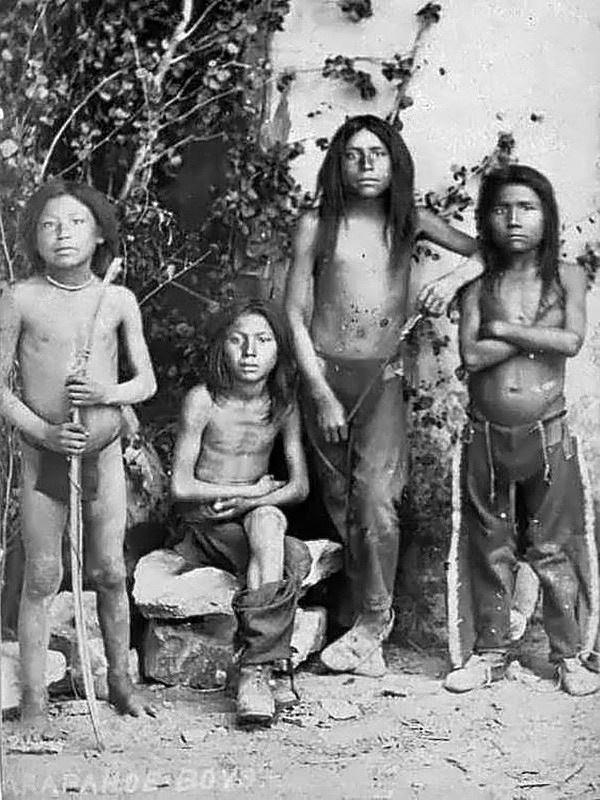
The Plains Tribes: The Arapaho

Figure 1.-- The Arapaho are one of the important Plaines peoples who acquired horses and hunted bufalo--the popular image of Native Americans. The photo depicts four Arapaho boys in 1882. They are wearing loincloths. For one of them this is the only garment while the others wear also leather chaps and moccasins.
|
|
Arapaho is the modern name for the tribe, but no one knows what it means or how it was acquired. One source suggests it may be a corruption of the Pawnee word for 'traders'. The Arapahos call themselves Hinono-eino or Inuna-ina which means 'our people' which is a common practice among Native Americans. Today they now commonly use the name Arapaho, sometimes spelled Arapahoe. The Arapaho once they acquired horses on the Great Planes, range widely on the planes. They were close allied with the Cheyenne tribe and loosely aligned with the Lakota and Dakota in inter tribl connflicts. After the Louisiana Purchase and the beggining of the settlement pf the West, the Arapaho inhabited the modern states of Colorado, Wyoming, Nebraska and Kansas. There are now two Arapaho tribes living on separate reservations. . The Northern Arapahos live on a reservation which they share with the Shoshone. The Southern Arapahos live on trust land together with the Southern Cheyenne. The U.S. Government deported the Southern Arapaho tribe to Oklahoma, where they joined together with the Cheyenne. The Northern Arapaho tribe remains in Wyoming today. Traditionally Arapaho bands were led by chiefs, respected men of the tribe. The chiefs were chosen by an Arapaho tribal council. Today Arapaho people share reservations with other tribes. As a result, tribal leaders are elected officials. The Arapaho language, Heenetiit, is an Algonquian language closely related to Gros Ventre, whose people are considereed an early offshoot of the Arapaho. It suggests that the origins of the tribe are to the east and north, one of many tribes driven west by English and then American settlers, although there appears to be a pre-contact Algonquian-speaking group on the central plaines. Arapaho people now speak English which is taught in the schools. Some elderly people still speak Arapaho. Their language is endangered because the children are not learning it. This is a common trend on many reservations, especially reservations with mixed tribal populations.
CIH

Navigate the Children in History Website:
[About Us]
[Introduction]
[Biographies]
[Chronology]
[Climatology]
[Clothing]
[Disease and Health]
[Economics]
[Freedom]
[Geography]
[History]
[Human Nature]
[Ideology]
[Law]
[Nationalism]
[Presidents]
[Religion]
[Royalty]
[Science]
[Social Class]
[Bibliographies]
[Contributions]
[FAQs]
[Glossaries]
[Images]
[Links]
[Registration]
[Tools]
[Children in History Home]
Navigate the CIH ethnic pages:
[Return to the Nain North Americn tribl page]
[Return to the Main Plains Tribes page]
[Return to the Main ethnic page]
[German]
[Greek]
[Irish]
[Scottish]
Navigate the CIH Native American pages:
[Return to the Main Native American cultural area page]
[Return to the Main Native American ethnic page]
[Return to the Main Native American page]
[Ethnic]
[Dance]
Created: 1:18 PM 6/16/2017
Last updated: 1:18 PM 6/16/2017



